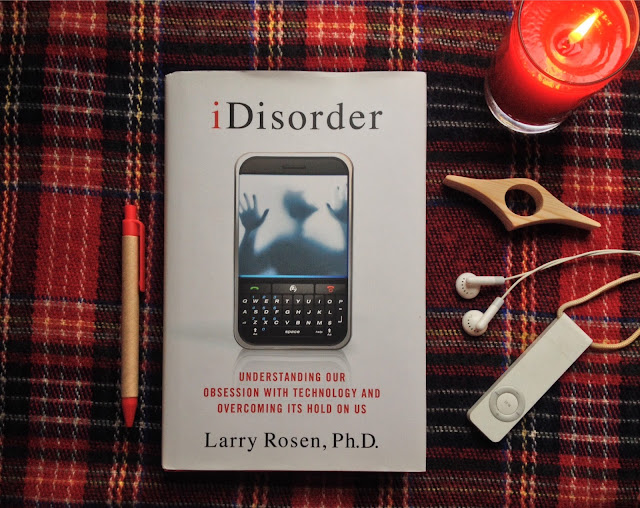iDisorder... Understanding Our Obsession with Technology and Overcoming Its Hold on Us / Larry D. Rosen..
Aslında çok ama çok uzun zamandır sırasını bekleyen bir kitaptı. İlk çıktığında görmüş fakat ancak 2 sene önce almıştı. Tam bu yaz okumaya başladığımda da uzun bir ara vermek durumunda kalınca kısmet şimdiye oldu.
Kitap güzel miydi ye geçecek olursam yorumum, son kertede iyi bir kitap olduğu şeklinde. Çünkü başlarda biraz zorlandım. Öyle ki biraz fazla akademik dille yazılmış olduğu için. Ee tabii yazar PhD olunca hâliyle alışkanlıklarından ötürü böyle yazmıştır ;) (Tecrübeyle sabit! :/ ). Ben bir ders kitabı gibi okumadığım, daha doğrusu o amaçla, güdüyle satın almadığım için biraz sıkıldım dilinden. Özellikle de başlarda. Çok fazla dipnot ve sayısal analiz rahatsız etti. Ancak sonra kitaba kaptırınca, hem diline alışınca hem de konu iyice sarınca (kendimden şeyler bulunca) sanırım o kısımlar daha az rahatsız edici gelmeye başladı. Onu da söyleyim.
Demem o ki siz de içinde bulunduğumuz teknolojik yoğunluğu anlayabilme adına okumaya karar verirseniz, başlarda hafif sıkılırsanız bırakmayın kitabı. Az sabredin açılıyor (Windows gibi sonradan :p ).
Genel anlamda kitap, çok güzel bir düzen içerisinde teknolojik aletlerle olan bağımlılık ilişkilerini ana başlıklar hâlinde kategorize ediyor; ayrı ayrı hepsine değinip hem sebeplerini hem gelişimini veriyor, hem artık bir ‘disorder’ olarak rahatsızlık seviyesinde olan durumlar için çok güzel çözüm önerileri sunuyor. Aralara çok güzel mini testler koyarak hem kendimizdeki seviyeyi birebir öğrenmemizi sağlıyor, hem de çok bildik yaşamdan örnekler üzerinden çok güzel analiz ediyor.
Bu arada çok manidar bir şekilde, tam dijital detoks yapayım diye düşünmeye başladığım bir dönemde sırası geldi ve okumaya başladım; tam okumaya başladım, kendiliğinden hayat bana sanırım iki ay falan bir dijital detoks yaptırdı! Çok enteresan.
Sonuç olarak, bazı örnekleri bir tık eskimiş olsa da (hem benim çok geç okumamdan kaynaklı olarak, çünkü sonuçta basım tarihi eski; hem de teknolojinin dehşet hızı nedeniyle ki hiçbir kitabın o hızı yakalaması mümkün değil kanaatindeyim) bunun saydığım sebeplerden ötürü bir negatiflik olmadığını düşünüyorum, instagram ve bloglarla haşır neşir bir kitle olarak okumamız gereken bir kitap olduğuna inanıyorum. Şahsen kendimin de bir noktada kendi çapımda tespit ettiğim hem olumlu hem olumsuz birkaç durumun bilimsel olarak da ortaya konabilen ve konan gerçekler olduğunu görmek bayağı bir şaşırtıcı oldu.
Son olarak kitapta yer alan ve dikkatimi çeken birkaç anekdotu, bilgiyi ve ifadeyi de sizlerle paylaşmak isterim:
- For minimal time and cost, the Internet in general and social networks in particular allow us to correspond with others who share our interests, meet people we would never otherwise meet, download entertaining software such as games, and keep in touch with friends. Psychologically, we benefit: We gain a feeling of status and trendiness, we are taken seriously and listened to, we can manipulate our online profile to suit our needs, and we are allowed to go on and on about interests that our physical family and friends might find very boring. [s. 71]
- Negative feelings and thoughts are not just associated with low self-esteem but also with other mental disorders. Depression and social anxiety might also be involved, especially as they are associated with disordered thoughts. Other conditions that can lead to negative thoughts include poor social skills and being lonely. Addictive substances, in this case technology, the Internet, and smartphones, provide, for many, an escape from these distressing thoughts. [s. 73]
- There are other possible factors influencing the development of addiction, too. For example, Dr. Young noted that negative life events—such as job dissatisfaction, medical illness, unemployment, and academic instability—could trigger addiction. The rewarding qualities of the Internet and the anonymity of being online could help these individuals avoid their suffering and dull their pain. [s. 73]
- However. the research is now showing that technology may act as a trigger to induce these mood swings. This is the precise definition of an iDisorder. [s. 78]
- In essence they showed that online social interactions have the same qualities as real-world interactions. More negative interactions thought about more often are more likely to evoke depressive symptoms regardless of whether it is face to face or on Facebook. [s. 86]
- Further, Holleran examined the exact words used in the status updates and found that more depressed people used fewer positive emotion words, more death-related words, more religious words, more metaphysical words (e.g., faith, moral), more swear words, and more negative emotion words (e.g., worthless, sad). [s. 87]
- Social compensation… People who are on social networks have more close friends and get more social support than those who are not on social networks. [s. 97]
- “liked” a post is the new millennial way of saying “I am thinking of you,” and all together the posts and ‘likes’ made her/him feel supported. [s. 99]
- We live in a plugged-in-world. [s. 105]
- Preoccupied with communicating in the cyber world, withdrawing into their own “TechnoCocoons”. [s. 124]
- Uses and Gratifications Theory says people choose to use certain media or technology because those systems and their content match their feelings, desires, values, or beliefs. [s. 148]
- Electronic voyeurism (e.g. the negative consequences of employers searching for the posted personal information) [s. 187]
- The researchers found that (a) one of the two main motivations for reading blogs was voyeurism, with users higher in voyeuristic intentions being more likely to read other people’s blogs. (b) The other main motivation for reading and posting blogs was impression management, which is people’s desire to present a coherent and meaningful representation of themselves online that might or might not match their personality offline. [s. 191]
- Face it: We are connected and we have created a cyber world that requires us to be connected.[s. 207]
- How do you know if you need a tech break?
* Tüm fotoğrafları, imleciniz resmin üzerindeyken sağ klikle yeni pencerede tek başına açarsanız, görseldeki yazıları çok daha büyük okuyabilirsiniz.









Comments
Post a Comment